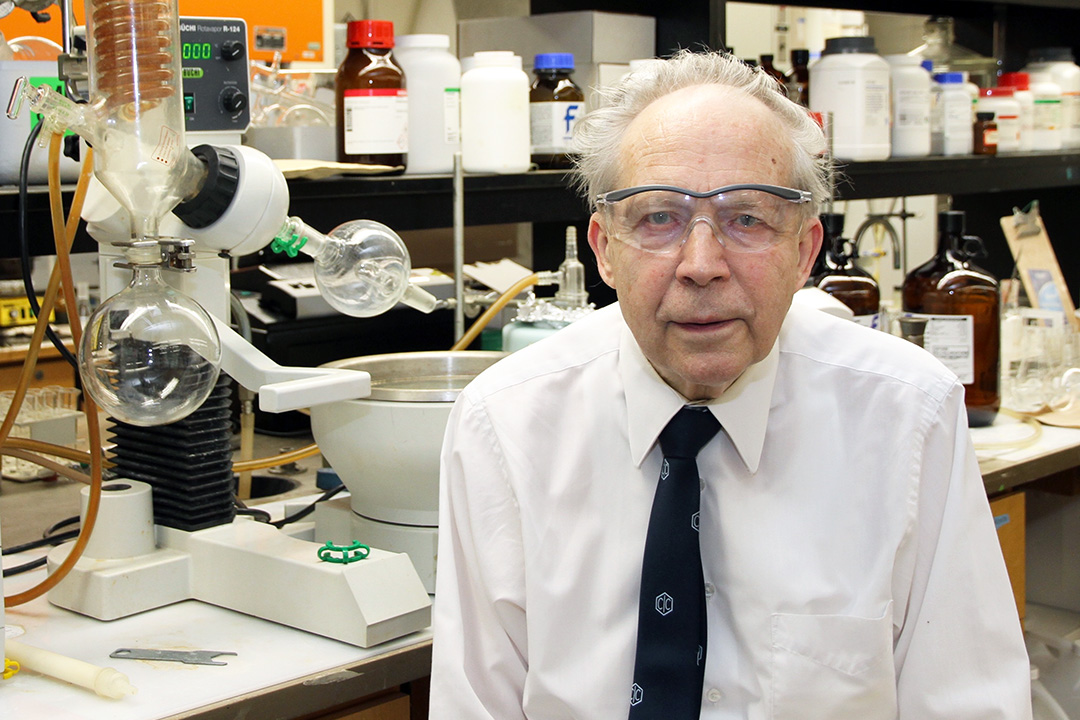
USask cancer researcher retired but still inspired
For someone who retired back in 2002, Dr. Jonathan Dimmock (PhD) sure has a funny way of not showing up for work.
By James ShewagaThe 82-year-old University of Saskatchewan (USask) researcher and professor emeritus celebrated his retirement on June 30, 2002 after 35 years as a professor in the College of Pharmacy and Nutrition. Two days later, he was right back in his lab and office, where he has spent the past 17 years conducting cancer research full time. So, after 52 years on campus, what keeps him coming back every day?
“It’s the research on anti-cancer drugs, that is what interests me and what we continue to work on,” said Dimmock, who walks to work and back home every day, 60 minutes in each direction, all year round. “Cancer is over a hundred different diseases and we have had some successes with drugs and surgery and so forth, but there is still much that needs to be done. And I will probably just keep going as long as I can.”
Dimmock has been honoured by the university for his ongoing commitment to research at USask, earning the 2017 University of Saskatchewan Retirees Association Continuing Contribution Award, recognizing retirees who continue to make research, scholarly, artistic or service contributions at an exceptional level.
For his part, Dimmock is appreciative of the support he continues to receive from the university and from external funding agencies.
“The University of Saskatchewan has been very good to me and they have allowed me to continue to have an office and to have labs to keep going. And since I retired, I have been funded externally, so I don’t think I cost the university very much,” he said with a smile.
Most recently, Dimmock was awarded $180,000 in 2018 from the Maunders McNeil Foundation Inc., in continued support of his research to create tumour-selective anti-cancer compounds for chemotherapy treatments, part of a $450,000 research grant over five years. Dimmock said the research is proving promising.
“We are working on several projects, one of which has been to take a compound forward through a number of different screens,” he said. “We have shown that it kills cancer cells and kills them selectively. In other words, we have found that the compound is toxic to the cancer cells, but far less toxic to non-malignant or non-cancerous cells, so we are pursuing this quite vigorously.”
Research is not only Dimmock’s passion, but also the biggest change that he has seen during his time on campus.
“The big change unquestionably, has been the emphasis upon research today,” he said. “When I came here 52 years ago, if my memory serves me correctly, in the 1967 era the total funding for the university for research from external grants and external contracts was about $5.5 million dollars. In 2017 to 2018, it was $642 million dollars in research grants and contracts. So that is a massive change.”
Born in England, Dimmock began his career at USask in 1967 and rose to full professor in 1976, creating a course on drug design and co-authoring a book entitled An Introduction to Drug Design in 1997.
Throughout his career, Dimmock has collaborated with colleagues in Belgium, Japan and the United States at the prestigious National Cancer Institute, with his research group’s studies on malaria followed up at the Walter Reed Army Institute of Research. Dimmock received the University of Saskatchewan Students’ Union Teaching Excellence Award in 1998 and was awarded a Doctor of Science from the University of London in 2001.
“That was based on 119 publications and three patents and a book, so I was honoured to receive it,” said Dimmock, who has now been a part of 242 publications and received 5,523 citations throughout his career. “But I think the highlights for me have been working with the graduate students, the post-doctoral fellows and the research technicians. I have always enjoyed the research and working with our students.”
